————- By Conservation Architect Sanaeya Vandrewala.
In light of the latest inscription of the Victorian Gothic and Art Deco ensemble of Mumbai into the UNESCO World Heritage List and in-keeping with the theme of the previous articles about contribution of Parsis to the growth of India and Bombay as a financial capital listed below are the buildings with either contributions of Philanthropic Parsis or designers of these superlative structures that constitute the World Heritage Site.
By the end of the 17th Century, mercantile communities were encouraged to settle to assist in the rise of Bombay city with assurance of religious freedom, liberty to trade and build homes. At the very beginning of the rise of Bombay, this laid the foundations for the city’s cosmopolitan character and robust financial strength. Among the first communities to settle were Gujarati Banias, Brahmins from Salsette, Parsis, and Armenians. These new communities added to the local population of Kolis, Bhandaris, Agris, Prabhus who were domiciled since the 13th century. By the end of the 18th century, a large population of Parsis had migrated towards Bombay. Parsis had merged with the Indian life and were doing well in various trades and businesses. By 19th century Parsis had become the foremost figures in Bombay establishing the first business houses in the country, they emerged at the local, district and regional level with social and economic gains that were elite based. Thus by the 20th Century Parsis along with other communities they played a major role in making Bombay the richest and the most important industrial and commercial center of India.
Bombay’s historic architecture was built on the foundations of public subscription, entrepreneurship, and philanthropy. Parsi industrialists and entrepreneurs, Hindu and Jain bankers and traders, Muslim and Baghdadi Jewish merchants, Armenians, Salsette Christians and English invested in the future of this emerging city, contributing to the urban landscape during the rise of Bombay.
With the cotton boom in the wake of the American Civil war and the opening up of the Suez Canal, Bombay emerged as a global port city in the 19th century. The demolition of the fort walls in the 1860s created a vast expanse of open space for the once fortified town, giving the British an opportunity to implement an ambitious urban design scheme to position Bombay as Urbs Prima in Indis, ‘the first city of India”, and second only to London in the vast British Empire.
- Convocation Hall, University Complex – Designed by Sir Gilbert Scott this is the most magnificent
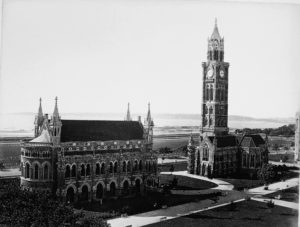
An archival image showing the Rajabai Tower and Convocation Hall, Bombay University architectural complex in the city. Sir Cowasjee Jehangir with a hefty donation of Rs. 1 lac to the total budget of Rs. 4 lacs generously contributed to the construction of this beautiful Venetian Neo-Gothic structure standing steadfast since 1874 facing the Oval Maidan.
- Elphinstone College – Designed by Khan Bahadur Mancherjee Murzban in a Neo-Romanesque style meant to house the Government printing press later was inaugurated in 1888 to house the Elphinstone College and State Archives, illustrious alumni including Sir Pherozeshah Mehta, Dadabhai Naoroji, Bhulabhai Desai, Dr. Bhimrao Ambedkar to name a few. A generous amount was collected by public subscription which had a huge sum contributed by Sir Cowasjee Jehangir.
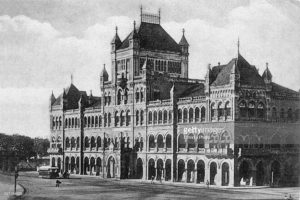
vintage photo-Elphinston College Bombay.
-
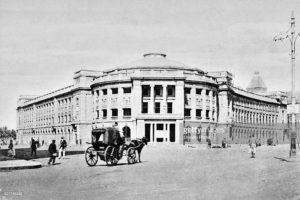
vintage photo-Institute of Science Bombay; present day Cawasjee Jehangir Hall Sir Cowasjee Jehangir Hall-National Gallery of Modern Art – Designed by the George Wittet, consulting Architect to Government of India who also designed the Gateway of India and Prince of Wales Museum, the Cowasjee Jehangir Hall stands in the crossing of two major roads whose foundation was laid in 1911 but the building was only opened in 1920 due to the outbreak of the World war in 1914. Designed in Renaissance Revival style the hall is an impressive 100 feet in diameter, housing the National Gallery of Modern Art since 1996 also built with a huge donation from Sir Cowasjee Jehangir.
- Jehangir Art gallery – Built-in 1950’s with funds from Cowasjee Jehangir family, the gallery was first of its
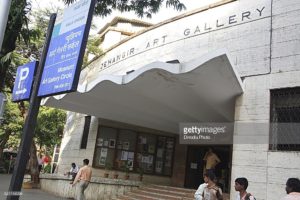
Horizontal Architecture Jehangir Art Gallery Bombay Mumbai Maharashtra India kind in the Kala Ghoda art district. Till date, the pavement plaza outside the gallery provides a platform for budding artists to showcase their art.
5. Regal Cinema – Designed by Charles Steven, son of Frederick William Stevens (famous for designing Victoria Terminus, Municipal Headquarters, Royal Alfred Sailors Home etc) was constructed in 1934 in Reinforced Cement Concrete and was one of the finest theatres in the city of Bombay owned by Globe Theatres Company of K.A. Kooka and F. H .Sidhwa. With interior murals designed by an expatriate Czechoslovakian, Karl Scahara, it is the finest Art Deco examples in the city.


6. Eros Cinema – Funded by entrepreneur Shavak Cambatta and designed by Sohrabji Bhedwar, constructed in the Art Deco style, Eros Cinema was inaugurated in 1938 and was the final word in style and elegance.
7. Several Art Deco buildings of the Backbay Reclamation Scheme completed in 1930’s built on the other side of Oval Maidan opposite the University Complex and along the Marine Drive had Parsi Architectural firms as designers to name a few, Contractor & Kanga, P.C. Dastur, Merwanjee & Bana, Mistri & Bhedwar, K.P. Daver etc and many of them had Shapoorji Pallonji as the Contractors.
To know more about the Mumbai world heritage site, heritage walks are conducted in the heritage precincts for further information or for private, customized tours please contact on email address heritagewalksmumbai@gmail.com or visit our facebook page https://www.facebook.com/MumbaiHeritageWalks/
Bibliography:
http://whc.unesco.org/en/list/1480/ for Mumbai’s inscription
Dwivedi, S and Mehrotra, R (1995) Bombay- The Cities within. Mumbai: Indian Book House Pvt. Ltd.
Dwivedi, S and Mehrotra, R (1999) Fort Walks. Mumbai: Eminence Designs Pvt. Ltd.
Photo credits- Getty Images
Note: Formerly known as Bombay in English, the name of the city was later adapted from its indigenous term in the state language Marathi into English in the year 1995 to be know called as
]]>
I must have been knee high to my dog Layal, when much to my chagrin, my mother exchanged all the cash presents for my birthday for a thick, fat very cobalt- coloured hard bound book and had it inscribed by the gift-givers. There was little I could do about it. I didn’t dare protest but Khurshed mamu did and ever since then, he was my hero.
Completely crest fallen, I hated that awful book…until my mother started to spend time reading it to me. It was her doing, her stories and her explanations that soon had me riveted to the book and demanding more and more of her time. The book, ultimately, provided me with strong roots and incited my interest in the ancient world and religion of Zarathustra.
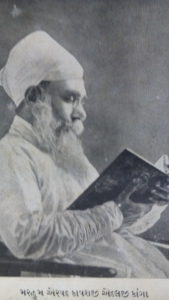 Neither mum nor I, and certainly not I at that tender age, understood the Avesta Language, and neither can I claim to do so today, but the book assisted by providing us with a translation of the Avesta in Gujarati. —- A word for word transliteration with each word numbered in the Avestic version and the same number given to the relevant translated word in the Gujarati Language. What a treasure!
Neither mum nor I, and certainly not I at that tender age, understood the Avesta Language, and neither can I claim to do so today, but the book assisted by providing us with a translation of the Avesta in Gujarati. —- A word for word transliteration with each word numbered in the Avestic version and the same number given to the relevant translated word in the Gujarati Language. What a treasure!
In time, I could read for myself; and today this transliteration of the Avesta which I offer is entirely dependent on this book by Mr. C E Kanga from which I was fortunate enough to read the Guajarati transliteration of our prayers.
When my brothers complained that our archaic religion offered them nothing and questioned how the religion hoped to inspire faith when the prayers were in a language long dead and beyond understanding; I remind them of their copy of Mr. Kanga’s book that went from their homes directly to the jari-puranawala with the old newspapers. A sad story!
I make this transliteration in the hope that those that are ‘interested’ may have some reference and some understanding of what they pray from the Avesta and may not resort to these same reason or excuse denigrating the religion.
Today, I can never thank Mr. Cowasji Eduljee Kanga enough for the time and effort he spent in writing and publishing the book which has become the main-stay of my understanding the ideas, tenets, people and thoughts from where I as a Zoroastrian emanate.
I can never thank my mother enough for converting my ice cream money to a gift so precious that it is has become a true and interesting companion.
Through this publication, I hope to bring a better understanding of our religion to friends and family alike as the Mr. Kanga’s book did for me.
As I was working on these translations my friends Khatu and Sarosh Framroze introduced me to a translation of the Zorastrian Daily Prayers in English, 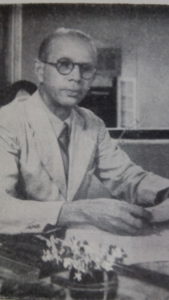 translated by Sarosh’s great grand-father Dosaabhoy Sorabjee Framroze; a work done between 1945 and 1968. Dossabhoy retired as the General Manager of the then Taj Hotels, and in his years found that the youth around him at the Dadar Parsi Colony carried a lot of misconceptions about the religion of Zarathustra; and thus, set himself to the task of translating our prayers in a known and well-understood language.
translated by Sarosh’s great grand-father Dosaabhoy Sorabjee Framroze; a work done between 1945 and 1968. Dossabhoy retired as the General Manager of the then Taj Hotels, and in his years found that the youth around him at the Dadar Parsi Colony carried a lot of misconceptions about the religion of Zarathustra; and thus, set himself to the task of translating our prayers in a known and well-understood language.
I thank Khatu, Sarosh and their daughter Nerrissa, who first directed my attention to Dossabhoy’s translation of the Avesta.
]]>